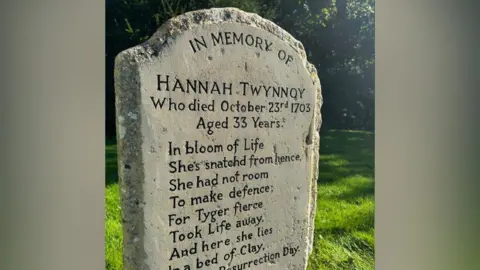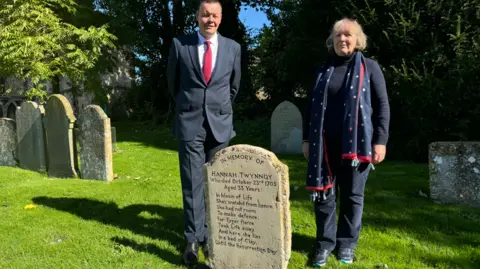Grave of woman killed by tiger in pub restored
 Ben Prater
Ben PraterA 300-year-old gravestone commemorating a woman who was mauled to death by a tiger has been restored.
Hannah Twynnoy was living in Malmesbury in the 18th Century when the animal, thought to have been part of a travelling menagerie housed in a pub yard, escaped and attacked her.
Her gruesome death, aged just 33, has attracted visitors to her grave in the grounds of Malmesbury Abbey ever since.
The inscription on her headstone had become so illegible that, prompted by a local campaign, masonry restorers were brought in to spruce it up.
Hannah Twynnoy was working as a servant in the White Lion Inn when she died on 23 October 1703.
Believed to be the first person to be killed by a tiger in England, the exact nature of her death is unknown as nothing was written about it until about 100 years later.
However, according to local history, the pub accommodated wild beasts for exhibition, one of which was a tiger.
Despite being told regularly not to tease the animals, it is believed that Hannah taunted the tiger, which lunged at her, pulled its fixing from the wall and "tore her to pieces".
 Ben Prater
Ben PraterLocal historian Christina Staff told BBC Wiltshire that it was unlikely Hannah's family would have been able to afford an elaborate headstone and somebody else would have paid for her burial.
"It would have cost a fair bit to put that (the headstone) there, but maybe the people who were responsible for her dying, through their guilt, could have supplied it," she said.
A poem carved on the stone includes the line, "For tyger fierce took life away"; a detail which has regularly drawn curious onlookers to the graveyard.
"(Her headstone) might not be contemporary; it could have been a bit later when people realised the story brought trade to the town," added Ms Staff.
 Athelstan Museum
Athelstan MuseumMalmesbury undertaker Chris Brooks said: "The restoration all came about because you couldn't really make out the inscription properly.
"Somebody wrote into the community magazine, the Jackdaw, and then everyone became involved.
"All the letters have been repainted by hand. We wanted to protect the lichen and to make sure the stone was still in keeping with the surroundings."
Follow BBC Wiltshire on Facebook, X and Instagram. Send your story ideas to us on email or via WhatsApp on 0800 313 4630.
